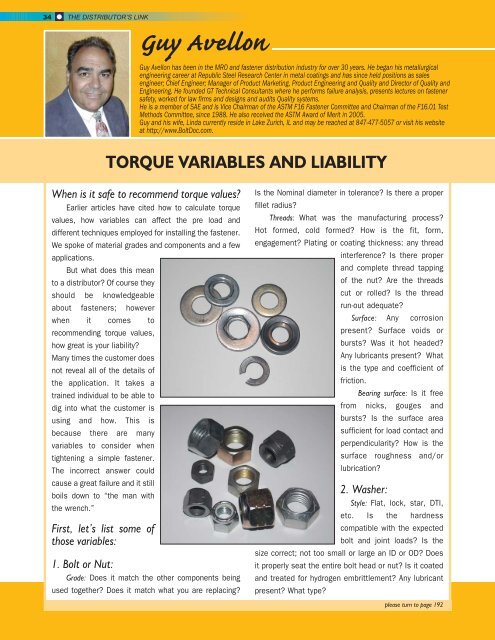SPRING 2012
Distributor's Link Magazine Spring Issue 2012 / VOL 35 / NO.2
Distributor's Link Magazine Spring Issue 2012 / VOL 35 / NO.2
You also want an ePaper? Increase the reach of your titles
YUMPU automatically turns print PDFs into web optimized ePapers that Google loves.
34 THE DISTRIBUTOR’S LINK<br />
Guy Avellon<br />
Guy Avellon has been in the MRO and fastener distribution industry for over 30 years. He began his metallurgical<br />
engineering career at Republic Steel Research Center in metal coatings and has since held positions as sales<br />
engineer; Chief Engineer; Manager of Product Marketing, Product Engineering and Quality and Director of Quality and<br />
Engineering. He founded GT Technical Consultants where he performs failure analysis, presents lectures on fastener<br />
safety, worked for law firms and designs and audits Quality systems.<br />
He is a member of SAE and is Vice Chairman of the ASTM F16 Fastener Committee and Chairman of the F16.01 Test<br />
Methods Committee, since 1988. He also received the ASTM Award of Merit in 2005.<br />
Guy and his wife, Linda currently reside in Lake Zurich, IL and may be reached at 847-477-5057 or visit his website<br />
at http://www.BoltDoc.com.<br />
TORQUE VARIABLES AND LIABILITY<br />
When is it safe to recommend torque values<br />
Earlier articles have cited how to calculate torque<br />
values, how variables can affect the pre load and<br />
different techniques employed for installing the fastener.<br />
We spoke of material grades and components and a few<br />
applications.<br />
But what does this mean<br />
to a distributor Of course they<br />
should be knowledgeable<br />
about fasteners; however<br />
when it comes to<br />
recommending torque values,<br />
how great is your liability<br />
Many times the customer does<br />
not reveal all of the details of<br />
the application. It takes a<br />
trained individual to be able to<br />
dig into what the customer is<br />
using and how. This is<br />
because there are many<br />
variables to consider when<br />
tightening a simple fastener.<br />
The incorrect answer could<br />
cause a great failure and it still<br />
boils down to “the man with<br />
the wrench.”<br />
First, let’s list some of<br />
those variables:<br />
1. Bolt or Nut:<br />
Grade: Does it match the other components being<br />
used together Does it match what you are replacing<br />
Is the Nominal diameter in tolerance Is there a proper<br />
fillet radius<br />
Threads: What was the manufacturing process<br />
Hot formed, cold formed How is the fit, form,<br />
engagement Plating or coating thickness: any thread<br />
interference Is there proper<br />
and complete thread tapping<br />
of the nut Are the threads<br />
cut or rolled Is the thread<br />
run-out adequate<br />
Surface: Any corrosion<br />
present Surface voids or<br />
bursts Was it hot headed<br />
Any lubricants present What<br />
is the type and coefficient of<br />
friction.<br />
Bearing surface: Is it free<br />
from nicks, gouges and<br />
bursts Is the surface area<br />
sufficient for load contact and<br />
perpendicularity How is the<br />
surface roughness and/or<br />
lubrication<br />
2. Washer:<br />
Style: Flat, lock, star, DTI,<br />
etc. Is the hardness<br />
compatible with the expected<br />
bolt and joint loads Is the<br />
size correct; not too small or large an ID or OD Does<br />
it properly seat the entire bolt head or nut Is it coated<br />
and treated for hydrogen embrittlement Any lubricant<br />
present What type<br />
please turn to page 192

















